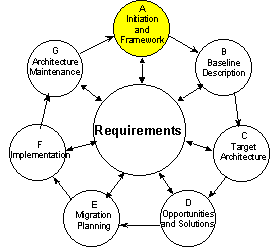 Objective
ObjectiveObjective Approach Inputs Steps Outputs
 Objective
ObjectiveThe objective of this phase is to define the relevant business requirements that apply to this evolution of the architecture, based on the principles, business goals and strategic drivers of the organization, and to define an architectural vision that demonstrates a response to those requirements.
Business Scenarios are an appropriate and useful technique to discover and document business requirements. Business Scenarios are described in Part IV of TOGAF.
Once an architectural vision is defined and documented in the Statement of Architecture Work, it is critical to build a consensus, as described in Part IV, IT Governance. Without this consensus it is very unlikely that the final architecture will be accepted by the organization as a whole. The consensus is represented by the sponsoring organization signing the Statement of Architecture Work.
This phase also defines what is in and what is outside the scope of the architecture effort and the constraints that must be dealt with. The constraints may be informed by a set of architectural principles, as explained in Part IV, Architectural Principles.
The phase starts with receipt of a Request for Architecture Work from the sponsoring organization to the architecture organization.
The inputs to this phase are:
Key steps in this phase include:
The outputs of this phase are:
Business Architecture - Version 1
Copyright © The Open Group, 1998, 1999, 2000, 2001